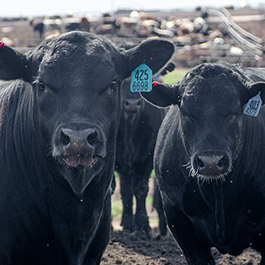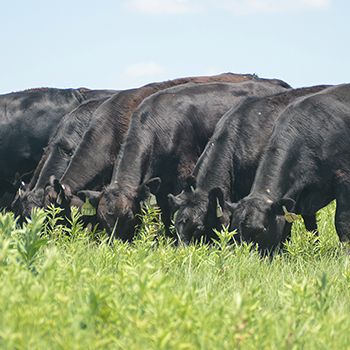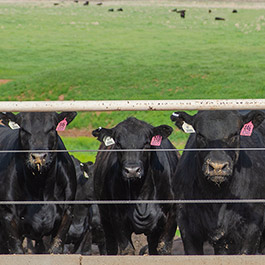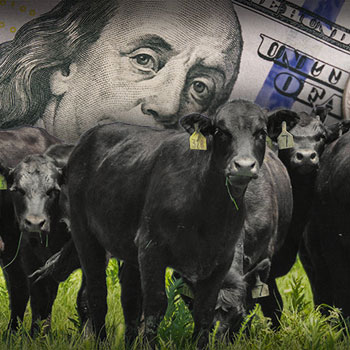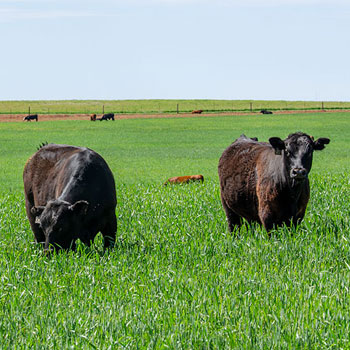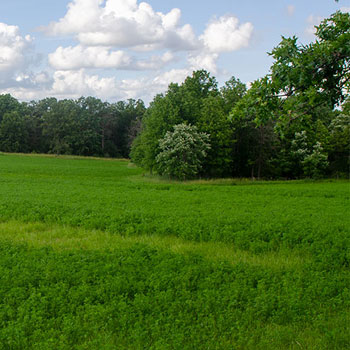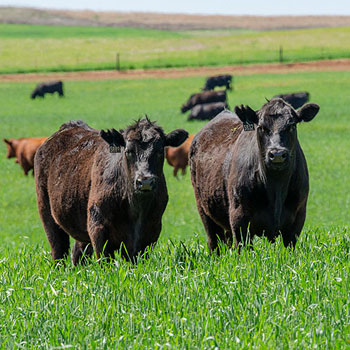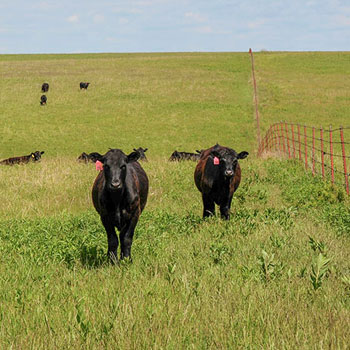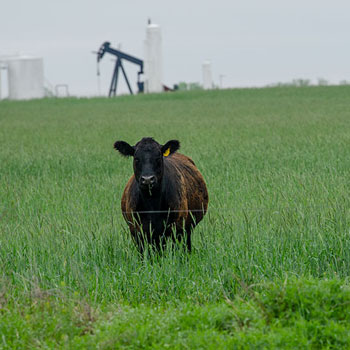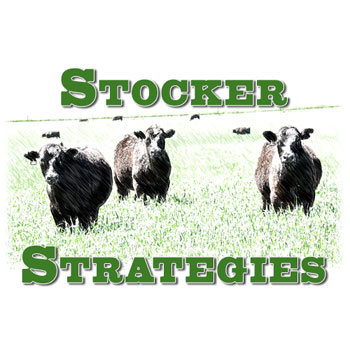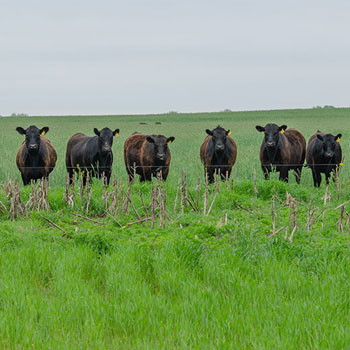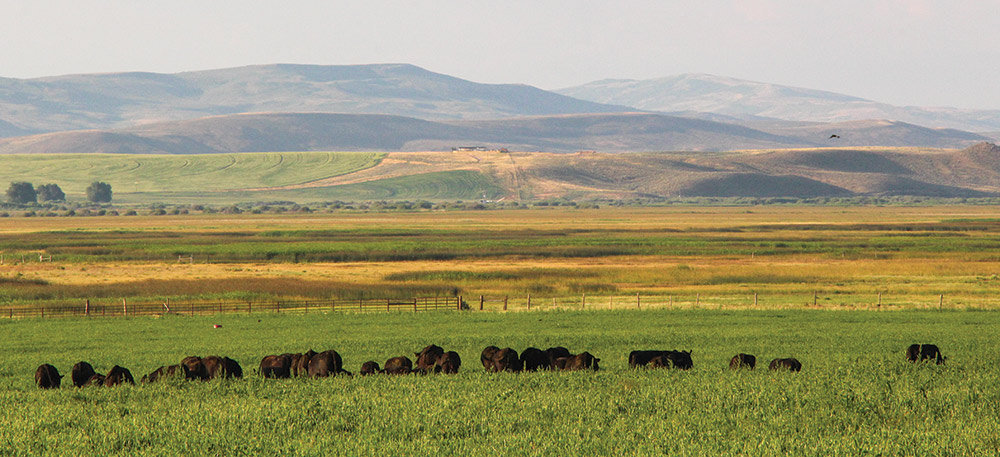
The Link to Profitability
Wyoming ranch uses AngusLink to increase premiums and operation growth.
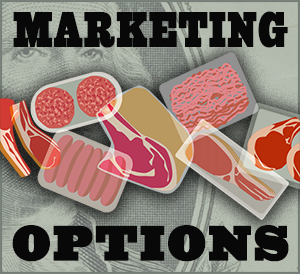
Jordan Willis decided he wanted to be a cowboy at age 3. He grew up driving tractors and branding calves, and simply never thought he wouldn’t raise cattle.
While Jennie didn’t grow up with this certainty or cattle background, she’s jumped in with both feet. Now she’s a vital part of the operation and can’t imagine doing anything else.
Having been together and ranching for more than 15 years, she says, “Anybody can do this if you work hard enough.”
The third-generation operation, Willis Ranch, near Cokeville, Wyo., supports the family purely with cattle and crops. Jordan and Jennie, with their four children, work with Jordan’s mom and three brothers to raise a herd of commercial Angus cattle, along with hay and small grains.
Recently, the opportunity to expand came at just the right time. The neighboring property came up for sale, and “things just seemed to click.” They were also able to buy some land they had been leasing for several years.
“It’s nice to have that comfort that those are ours now,” Jennie says.
With expansion comes the responsibility of earning additional income. The Willises sell all of their calves via Superior Livestock Auction’s video sales, and sell a good majority of their heifers as breeding stock. They are proponents of Angus genetics and use the tools available to them to garner more premiums.
Using the tools
The Willises have used tools provided by the American Angus Association for their commercial cattle herd for years. They’ve used GeneMax® AdvantageTM for the past five years. Jordan says he sees it as a great tool to select replacement females.
Buyers like to have it as a resource to prove their worth — extra validation, he says. The couple provides as much information to their buyers as they can. They gain trust, and buyers have certainty in the product they are getting. The Willises have gained repeat buyers because of this.
Jordan and Jennie test about 75% of their heifers at branding time. They use the information for the video markets, and it shows the heifers are comparable to their steer mates.
“We use GeneMax as a marketing tool, but it also helps us as a breeding tool,” Jordan says.
GeneMax offers SireTrace®, so they can identify the most productive and highest-quality sires. They use five to six different sire groups with separate groups in each pasture.
 |
Having used AngusSource for years as a way to differentiate their cattle, adding AngusLink, with its genetic-merit descriptions, when it was released was only natural. Now that the programs have been combined, the cost of enrolling has been reduced, which Jordan says he is excited about. |
They graze Bureau of Land Management (BLM) ground, so some pastures are 500 acres and some are 15,000. This means carrying capacity can vary from 75 head in some pastures to 600 pairs in others. They can have two bulls or 30 bulls in one breeding group.
“Before GeneMax, it was tough to identify the good bulls with that much variability,” Jordan says.
“We’re the kind of producer who believes in using technology to make our operation better,” he adds.
Marketing assistance
AngusLinkSM was a natural addition. They had also been using AngusSource® for years prior as a way to differentiate their cattle. They used the age-and-source verification and non-hormone treated cattle (NHTC) verifications. They added AngusLink with its genetic-merit descriptions when it was released.
“We like working with the American Angus Association. We work with the same people each time, and they know us and know our operation. It’s also cheaper and easier. All of our information is in one spot, and we only have to deal with one third-party audit this way. The tags through Angus are cheaper, too,” Jordan says.
Jennie adds, “The information we get back is easy to use. It’s simple. We don’t have to do a lot of homework to use it.”
Another advantage of working with AngusLink is the marketing help. The AngusLink network already includes 800 buyers who receive emails about where and when AngusLink calves are selling.
The Willises sell their calves via video auction in early July, to be delivered in early November. Jordan says they had a new buyer this year thanks to the marketing emails from AngusLink. On sale day, he was impressed there was an AngusLink representative there when his calves sold to promote both the program and their calves.
How it works
The draw of AngusLink at its conception was its Genetic Merit Scorecard®. Broken into three easy scores, it helps tell buyers the calves’ potential to perform in later segments.
Ginette Gottswiller, director of verification services at the American Angus Association, explains the beef value score ($B) shows potential for feedyard performance and carcass value by using carcass weight, marbling and feed efficiency expected progeny differences (EPDs) of sires, along with what’s known of the genetics of the cow herd. The feedlot score ($F) indicates potential for feedlot performance and uses average daily gain (ADG) and dry-matter intake (DMI) EPDs. The grid score ($G) indicates potential for carcass grid merit by using marbling (Marb), fat (Fat) and ribeye area (RE) EPDs.
The scores go from 0-200, so it’s easy to remember that industry average is 100. Gottswiller explains that anything above 100 is above average. Cattle that earn more than 125 on their grid score can add the Targeting the Brand™ logo from the Certified Angus Beef® (CAB®) brand to signal buyers that these cattle have potential to achieve those CAB specifications.
“We plan to continue using Age and Source and NHTC. I’m excited about the direction AngusLink is going. I think it’s a great tool,” Jordan emphasizes.
Since combining the AngusSource and AngusLink programs, the cost has reduced, something Jordan’s also excited about, he chuckles. In seriousness, he says their cattle bring premiums on sale day because of the program, though the amount varies year to year. It has been worth it to enroll in the programs, and he uses the tests available to improve the herd.
Enrollment is easy
The Willises didn’t have to change much of their recordkeeping to enroll. Enrolling is simple. Most cattlemen already keep the necessary records, Gottswiller says, and many operations qualify for more than one verification the first time they enroll.
Enrollment requires filling out the application, submitting calving records and vaccine receipts, and completing a training via telephone. An on-site audit will be arranged. Calling the Commercial Programs Department at 816-383-5100 can start the process.
 |
Jordan and Jennie Willis, with their four children (from left, Journee, 1; Jackson, 11; Joslyn, 8; and Jentry, 4), work with Jordan’s mom and three brothers to raise a herd of commercial Angus cattle, along with hay and small grains, near Cokeville, Wyo. |
The on-site audits are thorough, but they need to be, Jordan clarifies. They work hard to do things well, and he’s glad to be able to verify that.
Growing a family
While these tools do add more premiums, which certainly help them with expanding the operation, Jordan laughs that agriculture is not a well-paid career. However, there are plenty of non-monetary benefits.
The couple’s four children, aged 11, 8, 4 and 1, are involved in the operation as much as they are able. They work cattle on horseback, and each child enjoys being around cattle and helping in the hayfields.
Jennie admits it’s a lot of work to have them involved sometimes, but it’s fun, too. The oldest is showing keen interest in the operation.
“He was just born to be a ranch kid,” his parents say. “He’s a problem-solver at 11.”
The girls love the animals, and Jordan and Jennie love teaching the respect for life few other ventures can offer.
“This is such a great way of life. At the end of the day, it’s fun to see what you’ve accomplished,” Jordan says. “We are raising a quality family with quality cattle. It wouldn’t be the same if you couldn’t do this with family.”
While that 3-year-old boy probably wasn’t thinking about earning premiums for his cattle, his love of cattle has stayed the same. He just uses more technology to raise the best ones he can.
